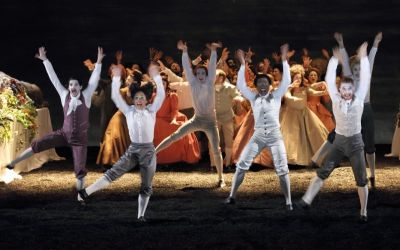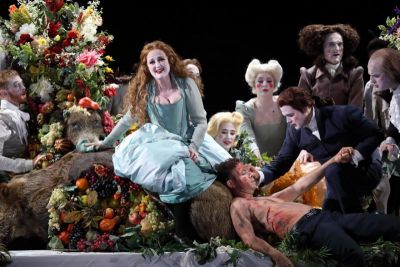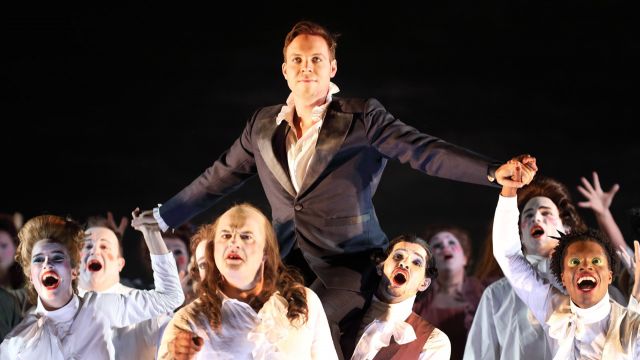Saul
If music be the food of life, then this feast, brought to the stage by Barrie Kosky, was ravenously devoured by the audience on opening night. Saul brings to the table, both literally and metaphorically, a meal of aural and visual delight.
From the moment the curtain was raised and an audible gasp enveloped the Festival Theatre, it was evident that this production would be a very different offering. A giant severed head on a raked stage was covered in crumbled black rubber. An enormous pair of banquet tables were adorned with amazing fruits, flowers, giant swans and a boar. This alone would have drawn an awed sigh. It was, however, the spectacle of the cast, posed like a colourful baroque painting perched atop this, that was the delicious sauce.
Handel’s English language opera Saul was written in 1738. First performed in London in 1739, the opera was recently revitalised by the Glyndebourne Festival in 2015. Barrie Kosky has re-envisioned this work beautifully for this year’s Adelaide Festival. He comments that he is an ‘extravagant minimalist’. This is very evident in this aesthetically different and challenging version of the piece. An adaptation of the biblical story of Saul and his descent into madness following David’s conquest of Goliath, it is a story of love, hate, desire, power and family on a lavishly grand scale. Kosky comments that he wanted it to be ‘a more surreal, abstracted and dreamlike world’ and that it is ‘very beautiful and at the same time slightly odd’. He absolutely achieves this goal as the baroque world of Handel clashes headlong with the biblical story in a world that never seems real, despite thrusting the audience headlong into the action.
 In staging this production, Katrin Lea Tag has created a world that is stark, yet lavish at the same time. The bare floor, strewn with rubber crumb, is in dialectical opposition to the bright, bold, baroque costuming. It certainly achieves Kosky’s goal of ‘the performer must be the centre’. Lighting design by Joachim Klein also highlighted the slightly surreal and dreamlike state of this production. His use of white light and front of stage up-lighting creates an ethereal, ghostly and at times grotesquely confronting palette.
In staging this production, Katrin Lea Tag has created a world that is stark, yet lavish at the same time. The bare floor, strewn with rubber crumb, is in dialectical opposition to the bright, bold, baroque costuming. It certainly achieves Kosky’s goal of ‘the performer must be the centre’. Lighting design by Joachim Klein also highlighted the slightly surreal and dreamlike state of this production. His use of white light and front of stage up-lighting creates an ethereal, ghostly and at times grotesquely confronting palette.
The players in Saul are astounding. British Bass-Baritone Christopher Purves embraces the madness and vivacity of Saul impeccably. His powerful vocals and physicality are compelling and he commands the stage at every moment. Throwing himself around the stage whilst plotting David’s demise and wildly showing his anger and power, Purves easily demonstrates why Kosky invited him to reprise his Glyndebourne role.
In stark contrast, American Christopher Lowrey’s crystal-like counter tenor voice brings an innocent beauty to the character of David. Handel’s utilisation of the highest voice for a male singer has encapsulated the boy-like quality of David, and Lowrey is a triumph. His clarity and sensuality is a joy to the ears.
Adrian Strooper displays great passion and ability as Saul’s son Jonathon, however I felt some of his vocals were not strong enough to match the power that is Handel’s orchestration.

Saul’s two daughters, played ably by Mary Bevan and Taryn Fiebig, are beautifully brought to life. Bevan is feisty and fiery as Merab, acting with strength and singing with a voice that is overwhelmingly beautiful. In contrast, the doting Michal, played by Fiebig, whilst vocally stunning brings a joyful innocence to the role, even jumping like a puppy when she wins the heart of David.
Stuart Jackson is the High Priest, who throughout the opera narrates and comments upon the story. He is portrayed in this production as almost a Court Jester meets Greek God, but his impact is far from flippant, as he draws the audience in with his purple claws and perfect vocals.
A moment in the opera that is quite confronting is the scene where Saul visits the Witch of Endor (Kanen Breen) to summon the soul of Samuel, with Saul digging into the depths he finds abhorrent. Visually creepy and supported by equally disturbing music, this scene, where the witch suckles Saul, is etched in my mind as one of the most uncomfortably intriguing scenes I have ever experienced in theatre.
 The State Opera Chorus, led by Brett Weymark, deserves a huge accolade. Not only vocally beautiful with perfect harmony, their athleticism is to be commended. Leaping apparently ‘effortlessly’ on and off thigh-high banquet tables on a raked stage is no mean feat. Their bewigged, baroque observations of, and participation in, the events occurring on stage are captivating. They are joy to the ears - particularly the beautiful opening piece “How excellent thy name o lord”. We are so fortunate to have such amazing local talent.
The State Opera Chorus, led by Brett Weymark, deserves a huge accolade. Not only vocally beautiful with perfect harmony, their athleticism is to be commended. Leaping apparently ‘effortlessly’ on and off thigh-high banquet tables on a raked stage is no mean feat. Their bewigged, baroque observations of, and participation in, the events occurring on stage are captivating. They are joy to the ears - particularly the beautiful opening piece “How excellent thy name o lord”. We are so fortunate to have such amazing local talent.
The music of this opera is brilliant, Handel at his best. The ASO again proves itself to be world standard and led by Dr Erin Heylard, the baroque specialist, this production could not help but soar. The energy and perfection of this group of musicians is laudable. Heylard himself has a spotlight moment when he appears, bewigged, playing the harpsichord during the production - a moment of genius.
Choreography in the production, by Otto Pichler using the sextet of dancers from the Glyndebourne Festival, is vibrant and engaging. Their acrobatic and anachronistic style, against the baroque background, drew many giggles and joyful smiles from the audience.
Whilst the offerings from the banquet that is Saul were plentiful, the audience were not sufficiently sated to leave the dinner table. Again and again, they clamoured for the cast to bow.
What a bountiful night of theatre!
Shelley Hampton
Photographer: Tony Lewis
Subscribe to our E-Newsletter, buy our latest print edition or find a Performing Arts book at Book Nook.

